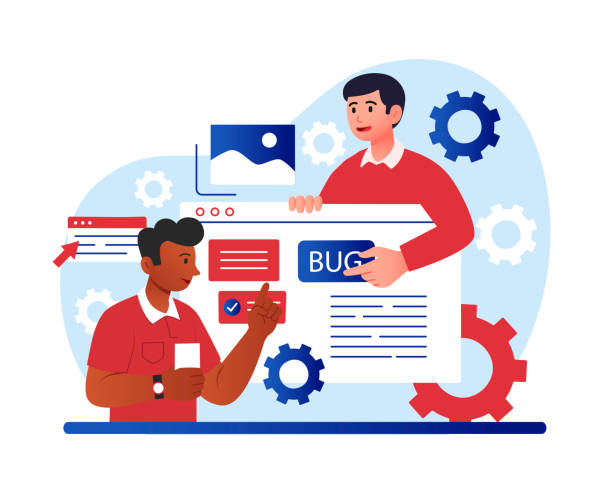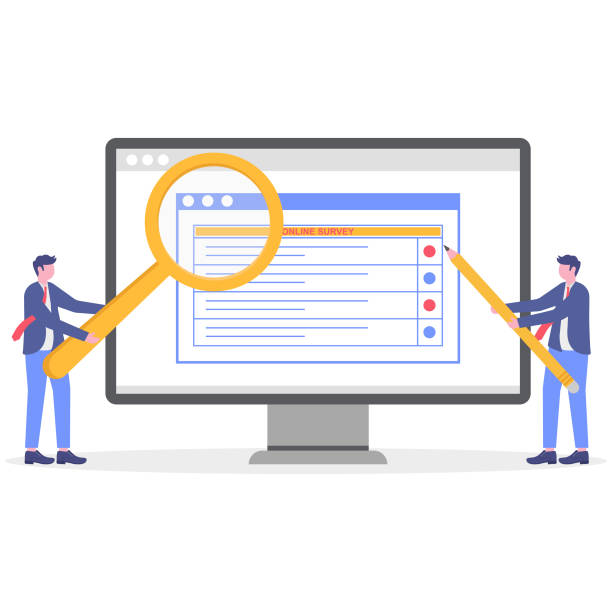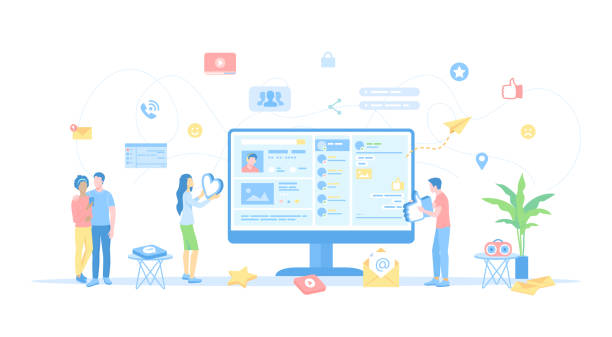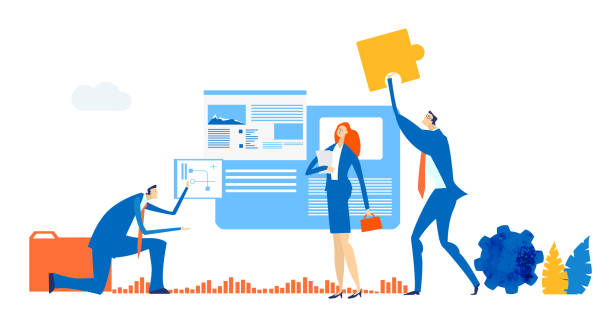Introduction to Secure Website Design Principles and Its Importance

In today’s digital world, which is growing in complexity and scope every day, secure website design is no longer a luxury option, but a fundamental necessity.
Website security not only means protecting sensitive user data, but also includes preserving a business’s reputation and preventing financial and legal damages.
#Secure_website_design starts from the very initial stages of website planning and architecture and continues through its maintenance and updates.
Without sufficient attention to this vital aspect, a website may be exposed to various types of cyberattacks that can lead to personal information disclosure, data loss, website destruction, or even abuse of server resources.
Cybersecurity is a broad concept, and secure website design is only a part of it, but a very key and important one.
This comprehensive process requires a deep understanding of potential vulnerabilities and the implementation of preventive solutions.
Web developers must be familiar with security concepts from the ground up and apply them at every stage of the Software Development Life Cycle (SDLC).
This includes choosing appropriate technologies, adhering to secure coding standards, and utilizing advanced security tools.
Secure website design means creating a robust defensive layer that protects information against unauthorized access, unwanted changes, and destruction.
The ultimate goal is for users to be able to use website services with confidence and be assured of the privacy and security of their data.
This assurance not only leads to customer loyalty but also prevents legal risks and heavy fines resulting from data breaches.
Therefore, continuous training and updating knowledge in web security is an essential and vital investment for any development team to ensure the stability and security of their websites against increasing threats.
Does your current website inspire the trust that potential customers should have in your business? If not, it’s time to get your professional and impactful corporate website with Rasaweb.
✅ Fully custom design tailored to your brand identity
✅ Increased lead generation and business credibility in the eyes of customers⚡ Contact us for a free consultation!
Why is Security Crucial in Website Design?

The fundamental question for any business owner or developer is: Why should we pay so much attention to secure website design? The answer lies in the real dangers and serious consequences that an insecure website can bring.
Every day, we witness news of large and small cyberattacks that lead to the theft of millions of user data, paralysis of business infrastructures, and irreversible financial losses.
Websites without sufficient security are easy targets for hackers, bots, and malware.
These threats can include DDoS attacks, SQL injection, cross-site scripting (XSS), session hijacking, and many others.
The result of these attacks is not just data loss; a brand’s reputation can be destroyed in an instant, and it can take years to restore.
Customers lose trust and move towards more secure competitors.
Furthermore, privacy and data protection laws such as GDPR in Europe or CCPA in California, mandate companies to adhere to strict standards in protecting user data and impose heavy penalties for non-compliance.
Therefore, secure website design is not only a technical preventive measure but also a vital strategy for preserving business values and adhering to social and legal responsibilities.
A secure website not only protects information but also improves user experience, as users can perform their interactions with greater confidence.
This investment in security yields high returns in the long term and prevents much higher costs resulting from security breaches and subsequent recovery.
Common Web Vulnerabilities and Prevention Methods

To achieve secure website design, we must first become familiar with the most common vulnerabilities that threaten websites.
Understanding these weaknesses is the first step towards defense and prevention.
One of the most common attacks is SQL Injection, which allows an attacker to take control of the database by inserting malicious SQL codes into input fields.
To prevent it, Prepared Statements or ORMs should be used, and user inputs should be carefully validated.
Another attack is Cross-Site Scripting (XSS), in which the attacker injects malicious JavaScript codes into the website to be executed in users’ browsers.
These codes can steal cookie information or deceive the user.
The solution is thorough input validation and output encoding (Output Encoding) to ensure that no malicious code is displayed on the page.
Cross-Site Request Forgery (CSRF) is also a common attack in which an attacker deceives an authenticated user into performing an unwanted request on the target website.
Anti-CSRF tokens or SameSite Cookies can be effective in preventing this attack.
Furthermore, poor session management, incorrect server security configurations, lack of proper access control, and the use of outdated and vulnerable components can all become weaknesses in secure website design.
The OWASP Top 10 project annually publishes a list of the 10 most critical web security vulnerabilities, which is a valuable resource for developers and security professionals.
Implementing strong authentication and authorization mechanisms, encrypting sensitive information, and continuously updating all software and libraries used are fundamental principles in creating a secure web environment.
Finally, continuous training of the development team on the latest threats and best security practices plays a vital role in maintaining website security.
Table 1: Common Web Vulnerabilities and Prevention Methods
| Vulnerability | Brief Description | Prevention Solution |
|---|---|---|
| SQL Injection | Injecting malicious SQL codes to access the database | Using Prepared Statements, ORM, Input Validation |
| Cross-Site Scripting (XSS) | Injecting malicious JavaScript codes into the user’s browser | Input Validation, Output Encoding, using Content Security Policy (CSP) |
| Cross-Site Request Forgery (CSRF) | Deceiving the user into performing unwanted requests without their knowledge | Using Anti-CSRF tokens, SameSite Cookies |
| Broken Authentication | Weak session and credential management | Strong Passwords, Multi-Factor Authentication (MFA), proper Session Management |
| Security Misconfiguration | Insecure default settings, server and software configuration errors | Reviewing and hardening configurations, removing unnecessary features, patch management |
Best Practices for Secure Coding and Development Standards

To achieve secure website design, one cannot rely solely on external tools or server settings; rather, security must begin from the core of the coding itself.
Adhering to best practices for secure coding and development standards is the cornerstone of an impenetrable website.
The first and most important principle is Input Validation.
Any data received from the user, without exception, must be validated before processing or storage.
This includes checking data type, length, format, and content to prevent the injection of malicious code or unwanted data.
The second principle is Output Encoding.
When stored or processed data is displayed on the page, it must be ensured that no code or special characters are interpreted as part of HTML, CSS, or JavaScript.
This is particularly vital for preventing XSS attacks.
Error Handling is also an important part of secure web development.
Error messages should not disclose sensitive information that could help attackers identify system weaknesses.
Instead, general and user-friendly messages should be displayed, and technical error details should be stored in secure server logs.
Another principle is the use of Parameterized Queries or ORMs for database interaction to prevent SQL Injection attacks.
This method separates data from SQL commands and prevents user input from being interpreted as part of the command.
Furthermore, proper Session Management must be considered.
Session IDs must be random and long, transmitted over HTTPS, and have an appropriate expiration time.
Also, strong encryption for any sensitive data, whether in transit or at rest, is essential.
For this purpose, using secure protocols like TLS for communications and robust encryption algorithms for stored data is mandatory.
Continuous updating of third-party libraries, frameworks, and components is also highly important, as many attacks exploit vulnerabilities in outdated software.
Projects like OWASP provide comprehensive guidelines and tools for secure coding, which can help development teams better structure their secure website creation processes.
Finally, programmers should adhere to the ‘Principle of Least Privilege’, meaning that each part of the code or each user should only have access to the minimum resources and permissions necessary to perform their task.
Tired of your company’s website not being seen as it should be, and losing potential customers? Solve this problem forever with professional and effective website design by Rasaweb!
✅ Increase brand credibility and gain customer trust
✅ Attract targeted sales leads
⚡ Contact us now for a free consultation!
User Data Protection and Privacy Compliance in Website Design

In the information age, user data protection and privacy compliance are among the most important aspects of secure website design.
This not only helps maintain user trust but also saves companies from heavy fines and legal consequences resulting from privacy law violations.
The first step in this regard is to minimize data collection to the essential minimum.
Collect only the data that is genuinely necessary for providing services or website functionality.
The less data collected, the lower the risk of security breaches and their consequences.
After collection, sensitive data must be encrypted (Encryption), both in transit (using SSL/TLS) and at rest in the database.
Strong encryption significantly reduces the possibility of data misuse, even in the event of unauthorized access.
Furthermore, strong Access Control systems must be implemented so that only authorized users with appropriate access levels can access sensitive data.
This includes managing roles and permissions in content management systems and databases.
Another important issue is transparency regarding how data is collected, used, and stored.
Privacy Policies must be clearly and understandably made available to users, and any changes to them should be communicated.
Users should have the right to choose whether to share their data and be able to easily access, correct, or request the deletion of their information.
These principles form the basis of laws like GDPR, which emphasize ‘Privacy by Design’; meaning privacy must be considered from the very initial stages of secure website design and not as an add-on feature.
Finally, there should be a plan for secure data deletion after they are no longer needed (Data Retention Policies) and also a Data Breach Response Plan for potential data breaches.
These comprehensive measures not only help increase website security but also contribute to creating a safer and more reliable digital ecosystem for everyone.
The Role of SSL/TLS Certificates and Firewalls in Enhancing Website Security
![]()
In the discussion of secure website design, two key and indispensable elements play a vital role in maintaining secure communications and protecting the website against threats: SSL/TLS certificates and firewalls.
SSL/TLS certificates (Secure Sockets Layer/Transport Layer Security) are the backbone of web communications security.
These certificates encrypt data exchanged between the user’s browser and the web server, ensuring that sensitive information such as passwords, credit card details, and personal data remain safe from attackers.
When a website uses HTTPS (the secure version of HTTP that uses SSL/TLS), a green padlock appears in the browser’s address bar, indicating a secure connection.
This not only builds user trust but is also highly important for SEO, as search engines like Google rank HTTPS-enabled websites higher.
There are various types of SSL/TLS certificates, including Domain Validation (DV), Organization Validation (OV), and Extended Validation (EV), each offering different levels of authentication.
Proper installation and configuration of these certificates is a fundamental step in any secure website development project.
Alongside SSL/TLS, firewalls also play a crucial defensive role.
Firewalls act as a barrier between the website and the internet, filtering incoming and outgoing traffic based on predefined security rules.
Two main types of firewalls are important here:
1.
Network Firewall: These firewalls operate at the network level and prevent unauthorized access to the server.
They can block specific ports or reject traffic from suspicious IP addresses.
2.
Web Application Firewall (WAF): WAFs are more specialized and operate at Layer 7 of the OSI model (Application Layer).
They can identify and block specific web attacks such as SQL Injection, XSS, and CSRF, even before they reach the web application itself.
WAFs can be implemented as hardware, software, or cloud-based solutions.
The correct integration of these two technologies into a website’s architecture provides multiple defensive layers that significantly enhance overall website security.
Without SSL/TLS, information is vulnerable to eavesdropping, and without firewalls, the website is directly exposed to continuous attacks.
Therefore, in any secure website design, these two tools must be considered as integral parts.
Regular Security Audits and Critical Updates

The process of secure website design does not end with website launch; rather, it is a continuous and dynamic process that requires ongoing monitoring, auditing, and updating.
Cyber threats are constantly evolving, and what is secure today might be a major weakness tomorrow.
Therefore, regular security audits and applying critical updates are fundamental pillars of maintaining website security over time.
One of the most important auditing tools is Penetration Testing.
In this process, security professionals (also known as ‘ethical hackers’) simulate real attacks to identify system vulnerabilities and weaknesses before actual attackers discover them.
Penetration testing can include black-box tests (without knowledge of internal structure) or white-box tests (with full access to code and infrastructure).
The results of these tests provide comprehensive reports of found vulnerabilities and solutions for addressing them.
In addition to penetration testing, Vulnerability Scanning should also be performed regularly.
These scans use automated tools to identify known vulnerabilities in operating systems, web software, databases, and other infrastructure components.
These scans are faster and more cost-effective than penetration testing and can be run continuously to monitor the website’s security posture.
Software updates are another critical aspect.
All software used on the website, including the server operating system, web server (such as Apache or Nginx), programming languages (such as PHP, Python, Node.js), databases (such as MySQL, PostgreSQL), and all frameworks, libraries, and plugins, must be regularly updated to the latest stable and secure versions.
Developers of this software are constantly discovering and patching vulnerabilities, and failure to apply these updates makes the website vulnerable to known attacks.
Also, Log Monitoring to identify suspicious and unusual activities, and regular backups of website data and code, are other important measures in maintaining website stability and security.
These measures are an integral part of a comprehensive secure website design strategy that helps maintain the health and efficiency of the website in the long term.
Table 2: Security Audit and Update Checklist
| Activity | Description | Recommended Frequency |
|---|---|---|
| Penetration Testing | Simulating attacks to discover vulnerabilities | Annually or after major changes |
| Vulnerability Scanning | Using automated tools to identify known vulnerabilities | Monthly or weekly |
| Operating System and Server Updates | Applying security patches and updates for OS and web server | As soon as released |
| Framework and Library Updates | Ensuring the use of the latest secure versions of frameworks, CMS, and plugins | As soon as released |
| Log and Event Monitoring | Reviewing server and application logs to identify suspicious activities | Daily/Continuously |
| Access Control Review | Reviewing user and administrator access levels | Quarterly or when roles change |
| Data Backup | Creating regular and secure backups of databases and files | Daily/Weekly |
Security Incident Response and Data Recovery Planning

Even with the best secure website design approaches and the implementation of the strongest security measures, the probability of a security incident never reaches zero.
Hackers are always finding new ways to infiltrate.
Therefore, having a well-defined and comprehensive Security Incident Response Plan and also a Disaster Recovery Plan is of vital importance.
These plans ensure that in the event of an attack, damages can be minimized, the system can be quickly restored, and recurrence can be prevented.
The incident response plan should include the following steps:
1.
Preparation: Identifying critical assets, forming the incident response team, defining roles and responsibilities, training the team, and creating necessary tools.
2.
Identification: Early detection of the incident through log monitoring, Intrusion Detection Systems (IDS), or user alerts.
Investigating and confirming the nature and extent of the attack.
3.
Containment: Preventing the spread of the attack.
This may involve disconnecting infected systems, applying firewalls, or changing sensitive passwords.
The goal is to isolate the infected section.
4.
Eradication and Removal: Identifying the root cause of the incident, fixing vulnerabilities, and removing any malware or unauthorized access.
5.
Recovery: Restoring systems and data to normal operational status.
This includes using secure backups and thoroughly testing systems after restoration.
6.
Lessons Learned and Improvement: Analyzing the incident, documenting experiences, and applying lessons learned to strengthen security measures and update the incident response plan.
The Disaster Recovery Plan (DRP) focuses on ensuring business continuity in case of complete data or system loss (such as server failure, natural disasters, widespread ransomware attacks).
This plan includes strategies for regular and automated backups, storing backup copies in secure and separate locations (Off-site storage), and continuous testing of the recovery process.
The goal is to minimize downtime and quickly and reliably recover data.
Having these plans not only provides peace of mind but also helps organize and reduce chaos during a crisis, preventing extensive financial and reputational damages.
Every secure website design should be carried out considering these scenarios and preparing for the worst-case scenario.
How much does losing business leads due to an unprofessional website cost you? Solve this problem forever with professional corporate website design by Rasaweb!
✅ Increase credibility and trust of potential customers
✅ Easier acquisition of new business leads
⚡ Get a free consultation now!
Future Trends in Web Security and Upcoming Challenges

The world of cybersecurity is constantly changing and evolving, and this dynamism directly impacts secure website design approaches.
For websites to remain secure in the future, it is essential to be aware of emerging trends in threats as well as advanced security solutions.
One of the most important trends is the increasing use of Artificial Intelligence (AI) and Machine Learning (ML) in the field of security.
These technologies can be used to identify complex attack patterns, detect unusual intrusions, and even predict future threats.
However, just as AI becomes a tool for defense, attackers will also use it to develop smarter and more automated attacks.
Cloud and Serverless architectures also create new challenges and opportunities for security.
While cloud service providers are responsible for infrastructure security, the security of code and data remains the developer’s responsibility.
This requires a deeper understanding of cloud security models and the implementation of secure website design approaches tailored to distributed environments.
The Internet of Things (IoT) and the proliferation of connected devices significantly increase the attack surface.
Websites that interact with IoT devices must ensure the security of these communications.
Blockchain, with its cryptographic and distributed capabilities, has the potential to create new security solutions for authentication, identity management, and data protection, but its implementation in web environments is still in its early stages.
Phishing and social engineering attacks will also continue to be among the most effective methods of infiltration.
User awareness and education to identify these attacks are important complements to technical measures for secure web development.
Also, the increasing use of Passwordless Authentication, such as security keys and biometrics, can help reduce risks associated with weak or stolen passwords.
Upcoming challenges include a shortage of cybersecurity professionals, the increasing complexity of systems, and the need for speed in development versus the need for security.
To address these challenges, secure website design must shift from a reactive to a proactive approach, where security is continuously integrated into the development cycle and not merely as a final stage.
International collaborations and threat intelligence sharing will also be vital for creating a more secure web environment globally.
Conclusion and the Importance of Sustainability in Secure Website Design

At the conclusion of this comprehensive review of secure website design, it can be concluded that website security is not an auxiliary feature, but the backbone of any successful online presence.
In today’s world, where digital and physical boundaries are intertwined, preserving the integrity, confidentiality, and availability of data and systems is vital for every organization and individual.
From the very initial stages of planning and architecture, to coding, deployment, maintenance, and even incident response, security must be embedded in every layer of a website.
We saw how understanding common vulnerabilities, implementing best practices for secure coding, protecting user privacy, utilizing technologies such as SSL/TLS and firewalls, and conducting regular security audits all contribute to building a secure and resilient website infrastructure.
Furthermore, the emphasis on preparing for incident response and data recovery indicates that security is a continuous journey, not a final destination.
Cyber threats are constantly evolving, so the approach to secure website design must also be dynamic and flexible.
Sustainability in web security means a continuous commitment to training, updating knowledge and technology, and adapting to the new threat landscape.
A team that adheres to security principles and continuously evaluates and strengthens its systems not only protects itself against attacks but also ensures user trust and business credibility.
Investing in website security is, in fact, an investment in the future and stability of a business in the digital age.
Without it, even the most innovative and functional websites will be at risk.
Therefore, the responsibility for creating and maintaining a secure website rests with all stakeholders, from developers and system administrators to senior management.
This shared commitment is the only way to successfully address today’s and future security challenges.
Frequently Asked Questions
| Row | Question | Answer |
|---|---|---|
| 1 | What is secure website design? | Secure website design is a process where websites are built with security measures in mind from the initial development stages to protect against cyberattacks, unauthorized access, and data loss. |
| 2 | Why is secure website design important? | Website security is crucial for maintaining user trust, protecting sensitive information (personal and financial), preventing damage to brand reputation, and complying with privacy and security regulations (such as GDPR). Security breaches can lead to financial and legal damages. |
| 3 | What are the most common cyberattacks a website faces? | Some of the most common attacks include SQL Injection, Cross-Site Scripting (XSS), Distributed Denial of Service (DDoS), Brute Force, and Credential Stuffing attacks. |
| 4 | What is SQL Injection and how can it be prevented? | SQL Injection is an attack where an attacker attempts to manipulate the database or extract information by injecting malicious SQL code into site inputs. To prevent it, Prepared Statements/Parameterized Queries, ORM (Object-Relational Mapping), and thorough input validation should be used. |
| 5 | What is Cross-Site Scripting (XSS)? | XSS is an attack where an attacker injects malicious scripts (usually JavaScript) into web pages that are executed by other users’ browsers. This can lead to the theft of cookies, session information, or alteration of the website’s appearance. |
| 6 | How can Brute Force attacks on login pages be prevented? | To prevent Brute Force attacks, CAPTCHA, limiting the number of failed login attempts (Account Lockout), Two-Factor Authentication (2FA), and using complex and long passwords should be employed. |
| 7 | What is the role of HTTPS in website security? | HTTPS encrypts the communication between the user’s browser and the website server using SSL/TLS. This prevents eavesdropping, tampering, or forging of information during transmission and increases user trust. |
| 8 | What is the importance of Input Validation in security? | Input validation is the process of checking and sanitizing data entered by the user. This prevents malicious code injection, XSS attacks, SQL Injection, and other vulnerabilities, ensuring that data conforms to the expected format. |
| 9 | Why are regular updates of website systems and software essential? | Regular updates of the operating system, CMS (like WordPress), plugins, themes, and libraries used address known security vulnerabilities. Hackers often exploit weaknesses in outdated software to infiltrate. |
| 10 | What role does regular backup play in secure website design? | Regular and tested backups of website data (database and files) are a vital layer of defense against data loss due to cyberattacks, human errors, or hardware failures. This allows for quick website recovery in the event of a disaster. |
And other services of Rasaweb Advertising Agency in the field of advertising
Smart Website Development: A professional solution for improving SEO ranking with a focus on Google Ads management.
Smart Digital Branding: A combination of creativity and technology to increase sales through SEO-focused content strategy.
Smart Data Analysis: A professional solution for digital branding with a focus on smart data analysis.
Smart Brand Identity: Designed for businesses seeking digital branding through the use of real data.
Smart Marketing Automation: Revolutionize customer acquisition with the help of an SEO-focused content strategy.
And over a hundred other services in the field of internet advertising, advertising consultation, and organizational solutions
Internet Advertising | Advertising Strategy | Advertorial
References
10 Key Tips for Increasing Your Website SecurityThe Importance of Protecting User Privacy on the WebWhy is an SSL Certificate Essential for Your Site?New Laws for Personal Data Protection in Cyberspace
? Ready to transform your business in the digital world? Reach the pinnacle of success with Rasaweb Afarin, specialists in SEO-optimized website design and comprehensive digital marketing strategies.
📍 Tehran, Mirdamad Street, next to Bank Markazi, Kazeroon South Alley, Ramin Alley, No. 6



